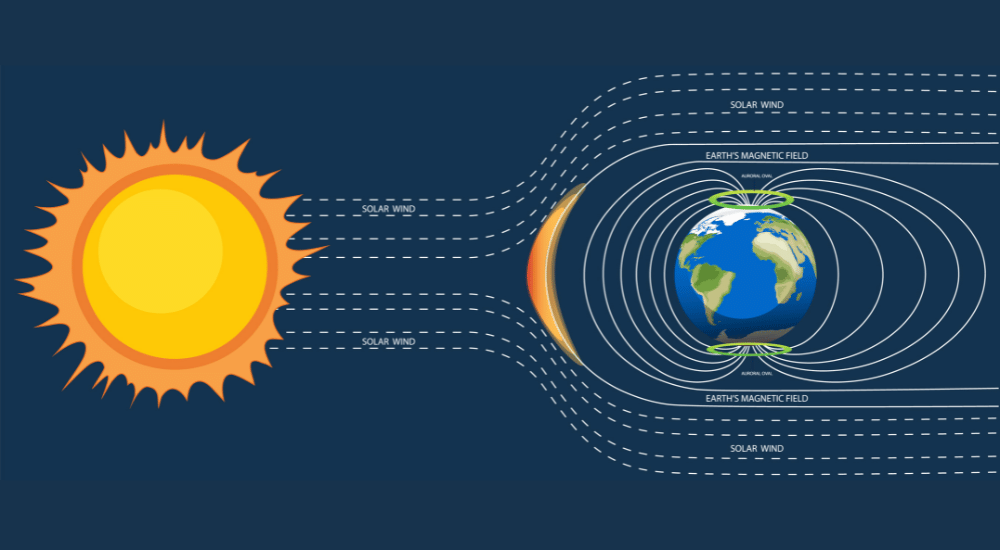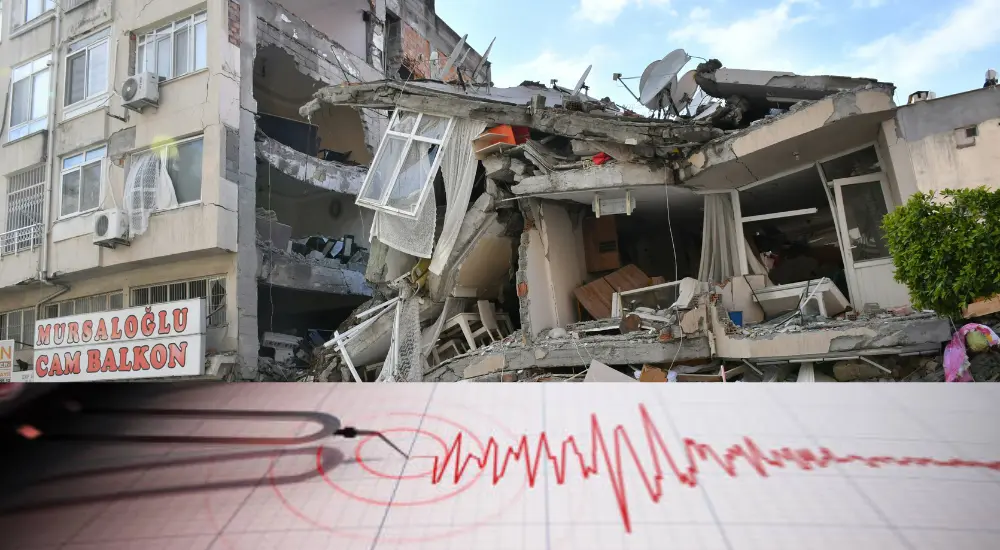Geomagnetism is the scientific study of Earth’s magnetic field and its influence on our planet. This captivating field of research delves into the origin, behaviour, and changes of the Earth’s magnetic forces, shedding light on phenomena like magnetic declination, auroras, and even past magnetic reversals. From the magnetic poles to the magnetosphere, Geomagnetism unravels the mysteries of our planet’s invisible shield.
Some important multiple-choice questions related to this topic are listed below. Try to answer these questions after reading enough in this topic. Also tie your answer with the given one. This practice may help you sharpen your preparation for any competitive exam along with increase your knowledge in this topic.
1. What causes Earth’s magnetic field?
(A) Solar radiation
(B) Earth’s rotation
(C) Tectonic plate movements
(D) Geothermal energy
(B) Earth’s rotation
Explanation: Earth’s magnetic field is primarily generated by the movement of molten iron in the outer core. This movement, driven by Earth’s rotation, creates electric currents, which in turn generate the magnetic field.
2. The region where the Earth’s magnetic field lines converge is called the:
(A) Magnetopause
(B) Magnetosphere
(C) Magnetic equator
(D) Magnetic poles
(D) Magnetic poles
Explanation: The region where the Earth’s magnetic field lines converge and enter or exit the Earth’s surface is known as the magnetic poles. There are two magnetic poles: the North Magnetic Pole and the South Magnetic Pole.
3. Which of the following materials is not commonly used in the construction of a magnetometer?
(A) Barium ferrite
(B) Superconducting wire
(C) Fluxgate sensors
(D) Aluminium foil
(D) Aluminium foil
Explanation: Aluminium foil is not commonly used in the construction of a magnetometer. Magnetometers are devices used to measure the strength and direction of magnetic fields. Common materials used in magnetometers include barium ferrite, superconducting wire, and fluxgate sensors.
4. What unit is used to measure the strength of a magnetic field?
(A) Ampere
(B) Coulomb
(C) Tesla
(D) Weber
(C) Tesla
Explanation: The strength of a magnetic field is measured in teslas (T). One tesla is a very strong magnetic field, so smaller units like millitesla (mT) or microtesla (µT) are often used for practical measurements.
5. The phenomenon in which Earth’s magnetic field reverses direction over time is called:
(A) Magnetic declination
(B) Magnetic inclination
(C) Magnetic reversal
(D) Magnetic induction
(C) Magnetic reversal
Explanation: Magnetic reversal refers to the phenomenon where the Earth’s magnetic field periodically reverses its direction over geological time. This means that the North and South Magnetic Poles switch places. These reversals have occurred numerous times throughout Earth’s history.
6. What is the approximate inclination angle of Earth’s magnetic field at the magnetic poles?
(A) 0 degrees
(B) 45 degrees
(C) 60 degrees
(D) 90 degrees
(D) 90 degrees
Explanation: At the magnetic poles, the Earth’s magnetic field lines are perpendicular to the Earth’s surface, resulting in an inclination angle of 90 degrees.
7. The study of how the Earth’s magnetic field has changed over time is known as:
(A) Palaeomagnetism
(B) Geodesy
(C) Seismology
(D) Petrology
(A) Palaeomagnetism
Explanation: Palaeomagnetism is the study of the Earth’s ancient magnetic field preserved in rocks. By analysing the magnetization of rocks, scientists can reconstruct the history of the Earth’s magnetic field and its changes over time.
8. What is the primary source of Earth’s magnetic field?
(A) Molten iron in the outer core
(B) Ocean currents
(C) Radioactive decay in the mantle
(D) Lightning discharges
(A) Molten iron in the outer core
Explanation: The primary source of Earth’s magnetic field is the movement of molten iron in the outer core. This convective motion, driven by heat from the core and Earth’s rotation, generates electric currents that produce the magnetic field.
9. What is the name of the boundary between Earth’s core and mantle, where the magnetic field is generated?
(A) Asthenosphere
(B) Moho discontinuity
(C) D” layer
(D) Outer core-inner core boundary
(D) Outer core-inner core boundary
Explanation: The boundary between the outer core and the inner core of the Earth, known as the outer core-inner core boundary, is where the Earth’s magnetic field is generated. The specific process involves the interaction of the liquid iron in the outer core with the solid inner core.
10. Which instrument is commonly used to measure changes in the Earth’s magnetic field?
(A) Gravimeter
(B) Magnetometer
(C) Spectrometer
(D) Seismograph
(B) Magnetometer
Explanation: Magnetometers are commonly used to measure changes in the Earth’s magnetic field. They can detect even small variations in magnetic field strength and direction, making them useful for studying geomagnetic activity, navigation, and geophysical research.
11. What is the name of the line connecting points on the Earth’s surface where the magnetic field is horizontal?
(A) Isoclinic line
(B) Isogonic line
(C) Isothermal line
(D) Isobaric line
(B) Isogonic line
Explanation: The line connecting points on the Earth’s surface where the magnetic field is horizontal is called the isogonic line. It represents the locations where the magnetic declination (the angle between true north and magnetic north) is the same.
12. What is the term for the deviation between true north and magnetic north?
(A) Magnetic inclination
(B) Magnetic reversal
(C) Magnetic declination
(D) Magnetic induction
(C) Magnetic declination
Explanation: Magnetic declination refers to the deviation between true north and magnetic north. It represents the angle between the direction of the Earth’s magnetic field and the direction towards the geographic north pole.
13. Which instrument is used to measure the strength and direction of the Earth’s magnetic field?
(A) Seismograph
(B) Barometer
(C) Magnetometer
(D) Anemometer
(C) Magnetometer
Explanation: A magnetometer is an instrument used to measure the strength and direction of the Earth’s magnetic field. It is commonly used in various fields such as geophysics, navigation, and scientific research.
14. The region where the Earth’s magnetic field interacts with the solar wind is known as the:
(A) Magnetopause
(B) Magnetosphere
(C) Magnetic equator
(D) Magneto sheath
(A) Magnetopause
Explanation: The magnetopause is the boundary region between the Earth’s magnetosphere and the solar wind. It is the point where the pressure from the solar wind is balanced by the Earth’s magnetic field.
15. What causes the auroras (Northern and Southern Lights) in Earth’s atmosphere?
(A) Solar wind particles interacting with the magnetosphere
(B) Lightning discharges in the ionosphere
(C) Geothermal activity near the Earth’s surface
(D) Volcanic eruptions releasing charged particles
(A) Solar wind particles interacting with the magnetosphere
Explanation: The auroras, also known as the Northern Lights (Aurora Borealis) and Southern Lights (Aurora Australis), are caused by charged particles from the solar wind interacting with the Earth’s magnetosphere and entering the atmosphere near the poles.















